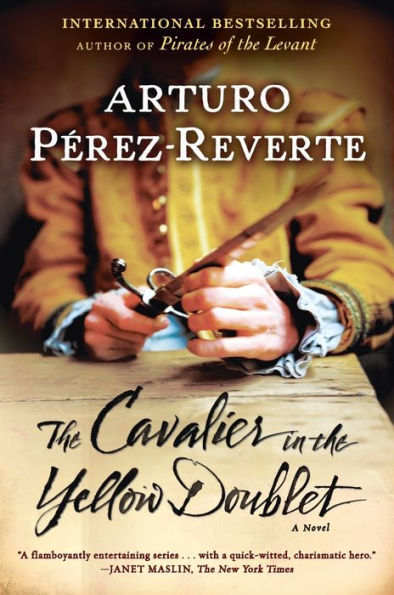5
1

Cavalier in the Yellow Doublet (Capitan Alatriste Series #5)
384
by Arturo Pérez-Reverte
Arturo Pérez-Reverte

Cavalier in the Yellow Doublet (Capitan Alatriste Series #5)
384
by Arturo Pérez-Reverte
Arturo Pérez-Reverte
Paperback
$22.00
-
PICK UP IN STORECheck Availability at Nearby Stores
Available within 2 business hours
Related collections and offers
22.0
In Stock
Overview
The fifth novel in the adventures of Captain Alatriste, a seventeenth-century swashbuckler and "a twenty-first-century literary phenomenon"(Entertainment Weekly). In the cosmopolitan world of seventeenth-century Madrid, Captain Alatriste and his protégé Íñigo are fish out of water. But the king is determined to keep Alatriste on retainer--regardless of whether his "employment" brings the captain uncomfortably close to old enemies. Alatriste begins an affair with the famous and beautiful actress, María Castro, but soon discovers that the cost of her favors may be more than he bargained for--especially when he and Íñigo become unwilling participants in a court conspiracy that could lead them both to the gallows.

Product Details
| ISBN-13: | 9780452296503 |
|---|---|
| Publisher: | Penguin Publishing Group |
| Publication date: | 08/31/2010 |
| Series: | Capitan Alatriste Series , #5 |
| Pages: | 384 |
| Product dimensions: | 5.30(w) x 7.90(h) x 0.90(d) |
| Age Range: | 18 Years |
About the Author

Arturo Pérez-Reverte's novels have captivated readers around the world and earned him a reputation as "the master of the intellectual thriller" (Chicago Tribune). Originally a war correspondent, he now writes fiction full-time. His novels include the Captain Alatriste series, The Flanders Panel, The Club Dumas, The Fencing Master, The Seville Communion, The Nautical Chart, The Queen of the South, and What We Become. His books have been published in fifty countries.He is a member of the Spanish Royal Academy. He lives near Madrid, Spain.
Reading Group Guide
INTRODUCTION
In 17th–century Madrid, Captain Diego Alatriste and his apprentice, Íñigo Balboa, are attempting to enjoy the tenuous peacetime Spain has gained after the Hundred Years War. They occupy themselves with literature and theatre, spending time with their old friend and celebrated poet Francisco de Quevedo. Instead of exchanging gunfire with the French, they exchange witty repartee about the latest plays and the authors who wrote them. The most popular dramas of the day, however, reflect the lives its citizens, and all of their romance, scandals and violence, and so it isn't long before the Captain and Íñigo find themselves entangled in another intrigue—this time a plot against King Philip himself.Their romantic lives have much to do with the mess they find themselves in. The Captain has entered into a dalliance with Madrid's most famous, and famously beautiful, actress—Maria de Castro, and both her actor husband and several members of the king's court have reason to object to their love affair. Meanwhile, Íñigo finds himself led right into harm's way by the angelic–looking and dangerously seductive Angelica de Alquézar, the niece of Captain Alatriste's powerful enemy, Luis de Alquézar, and a member of the queen's court. Soon, Alatriste and his loyal apprentice are in more danger of losing their liberty, and even their lives, on their home soil than they ever were in foreign lands during times of war.The latest in the Arturo Pérez–Reverte's series of novels about the adventures of Captain Alatriste, The Cavalier in the Yellow Doublet continues the tale of this captivating swashbuckler.Filled with suspense and action, as well as minute historical detail, The Cavalier in the Yellow Doublet depicts 17th–century Spain and all of the corruption, deception and betrayal that ran through its royal court at the height of its wealth and opulence.ABOUT ARTURO PÉREZ–REVERTEArturo Pérez–Reverte lives near Madrid. Originally a war correspondent, he now writes fiction full–time. His novels include The Flanders Panel, The Club Dumas, The Fencing Master, The Seville Communion, The Nautical Chart, and The Queen of the South. In 2002, he was elected to the Spanish Royal Academy.
DISCUSSION QUESTIONS
From the B&N Reads Blog
Page 1 of
